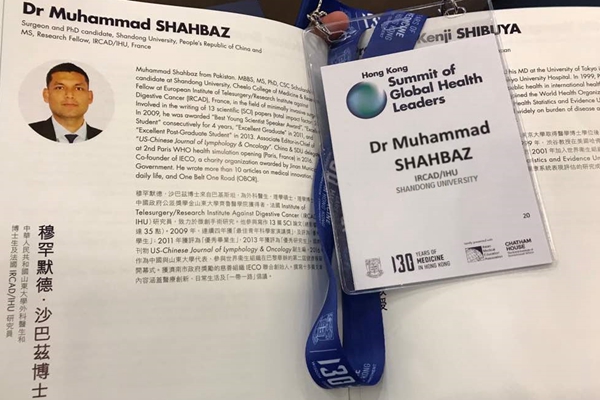
I participated in the Summit of the Global Health Leaders in Hong Kong in December, 2017. It was an amazing experience for me to attend the Summit as the youngest speaker.
The inaugural Summit of the Global Health Leaders was held in Hong Kong under the flagship event of the130th anniversary celebrations of the Faculty of Medicine of the University of Hong Kong. Participants from all around the world came together to discuss key global health issues of our time: new challenges arising from the evolving global geo-economic-political environment, future models of training the next generation of health professionals, and the meaning of a New Silk Road to Health under the "Belt and Road" vision.

Speakers from the leading medical universities and hospitals as well as government officials participated in this event. There were 3 plenary sessions, 7 panel discussions and the joint session by the Chatham House themed "The New Silk Road to Health" together with the joint session by the Asian Medical Education Association themed "Rethinking the health Professions".
Listening to the speakers and the panel discussion gave me a thoughtful knowledge about the history of Silk Roads, the impact and main plans of the New Silk Roads, the diplomatic relationship among the countries connected indirectly to the New Silk Roads, and the mission of medical education reform of China.
Through the discussions of the panel,I came to know about the recommendation for easier transport to markets in remote areas: implications for food and pharmaceutical regulations, robust health systems for the existing neglected communities, new migrants and new international scientifism along the Belt and Road, and new partnership in health development aid.
Richard Horton, Editor in Chief of the Lancet, UK, gave a thought provoking and state-of-the-art concluding reflections to the whole summit.
 |
 |
I participated in the summit representing Shandong University, China, and IRCAD/IHU, France. I also felt proud to participate as a Pakistani. I briefly gave my idea and feasibility study about the development of the Health Corridor across the Belt and Road.Belt and Road (B&R) brings a wide range of opportunities and connectivity options for all nations which are linked indirectly. It can also turn out to be a "health corridor". The Health Corridor might consist of state-of-the-art medical cities, regional health centers, provincial stations, and peripheral units along the Belt and Road (B&R), each including a hospital, nursing and paramedical institutes, a medical college, a central research laboratory, an innovative medical equipment training center, a virtual university and an IT connection center. I described briefly how rural healthcare units in remote areas can be linked to major hospitals, to which establishing joint laboratories or research centers, international technology transfer, and knowledge translation centers is key. The use of telemedicine, telesurgery, and remote audiovisual training with full use of computer science, IT and artificial intelligence technology is essential to keep the digital data of patients in the form of face recognition, fingerprint, retina scan-enabled medical history, as well as centralized and decentralized connected data of patients using big data platforms. It is very important that we "Take medicine to Patient, not Patient to the medicine" by Federico Davrieux.

the proposed logo of B&R Health Corridor designed by Dr. Muhammad Shahbaz
The pharmaceutical industry, traditional Chinese medicine (TCM), regional herbal medicine, medical research, and medical staff exchange programs can be established to train doctors and medical staff with advanced medical training and surgical skills including laparoscopic and robotic surgery. Continuing medical education (CME), exchange programs, and medical university campuses could be established along the B&R connected via online medical education platforms. Foreign medical graduates from China and local faculty exchange programs with a collaborative approach can be helpful to address health issues. They will be useful for capacity building in the prominent institutions of countries. State-of-the-art research laboratories and innovative medical equipment would be extremely helpful for research and development.
There is a need to set up specialized herbal research institutions to develop the Industry and educate health regulators in every country. It is crucial to create a multidisciplinary link between hospitals, research centers, teaching institutes, universities, researchers, academics, IT & pharmaceutical & medical research, companies and experts that will ultimately promote the exchange of information required for capacity building in innovation and advanced therapies. It is critical to bring together a pool of B&R doctors, nurses, and medical staff connected via telemedicine for mobile hospitals, medical tourism, as well as sea and land routes for hospital mobilization. It is essential to promote regional cooperation and coordination in maternal and child health, disability rehabilitation, and management of major infectious diseases, immunizations, infectious diseases data control in disaster-hit areas. International branches and campuses of hospitals and universities must be established as platforms to improve capabilities of handling regional public health emergencies through epidemic information sharing, as well as abilities of exchanging prophylactic and interventional methods. I briefly described my experience in China, Pakistan, Australia and France and put forward the idea to connect the Belt and Road countries using the regional health care center and creating a "Belt and Road medical force" to move actively in case of natural disasters or medical emergencies.

The future of medicine is very promising where the surgeries will be automatic and people will have their own robots at home/ office or other places to get the treatment. I am looking forward to see the success of the Belt and Road and very hopeful to witness the New Health Corridor in the years to come.
Written by Muhammad Shahbaz (Ali), Ph. D. student of General Surgery on CSC Scholarship, School of Medicine, Shandong University, research fellow at the Department of General Surgery, Qilu Hospital of Shandong University
Edited by: Xie Tingting